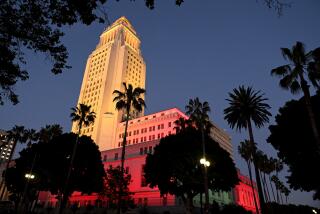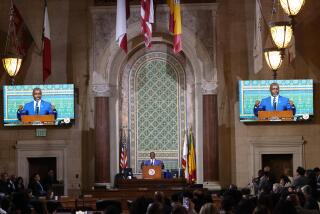L.A.’s Central Avenue gets its own City Hall
There are ice plants and clusters of aloe on the roof, with views of the Hollywood sign in one direction and the San Gabriel Mountains in another. The building’s engineers seem to have stars in their eyes when they talk about its high-tech components -- an irrigation system powered by rainwater; solar panels that automatically track the arc of the sun.
Step back onto the street, and the familiar parade of South Los Angeles imagery -- weed-choked lots, graffiti on light poles and anything else that doesn’t move -- seems especially jarring. Then again, the Central Avenue Constituent Services Center has been a source of curiosity ever since the angular Space Age facility began rising above South Central Avenue, one of the more storied and troubled thoroughfares in the city.
Now, the $14.7-million satellite City Hall, at Central and East 43rd Street, is set to open. Already, some members of City Councilwoman Jan Perry’s staff have moved in. The one-acre complex, including a 1,500-square-foot community center and an adjoining, 7,500-square-foot city services center -- and the first “green” roof on a municipal building in L.A. -- will open to the public on Jan. 28.
It will be another important step in the resurrection of Central Avenue, officials believe.
“We’re on a roll,” Perry said. “It’s going to lift people’s spirits -- and, hopefully, lift their property values.”
Central Avenue was seminal in the development of Los Angeles, particularly its southern end. “It was the backbone of the community,” Perry said, and it was once dotted with a dozen clubs where West Coast jazz was, by and large, invented. But it was never a wealthy place, and when nearby factories closed in the 1960s and downtown union jobs vanished, “The Avenue,” as it was known, degenerated into deep economic depression. But it has seen a recent wave of construction and a resurgence of energy.
In September, for instance, a new supermarket opened at Central and 20th Street, part of a $27.5-million mixed-use project. In such a poor, financially stagnant area, the opening was viewed as so significant that there were 800 people in line -- and a marching band.
The avenue still has more than its share of problems. But there are also new schools, church refurbishment projects and additional mixed-use developments offering scores of new housing units. A Fresh & Easy Neighborhood Market, which is scheduled to open at Central and Adams Boulevard on Feb. 24, held a job fair earlier this month.
“Even though it’s taken a long time, we are really hitting critical mass,” Perry said.
The opening of the constituent services center is not the end of the new development. Next, city officials want to turn their attention to the landmark Dunbar Hotel, which is just up the street.
The hotel was once the pride of African American Los Angeles, and jazz luminaries -- Count Basie, Cab Calloway, Lena Horne and others -- stayed there during the heyday of West Coast jazz. Now a low-income apartment building, it has fallen into disrepair and been placed into receivership. The city is preparing to weigh proposals to refurbish it as affordable housing while preserving its character.
Seven years in the making, the constituent services center was built on a site that was home to the Bombay Candle & Botanica warehouse, which had suffered extensive damage from termites and a fire. Construction was financed largely through city infrastructure bonds.
From the start, the city was aiming for something new, said City Engineer Gary Lee Moore.
“This is an urban park that just happens to have a building on it,” he said. “You don’t want it to be a fortress. All public buildings should be welcoming and inviting.”
In a neighborhood where crime is an everyday concern, that required some innovative design features. For example, the building needed to be surrounded by a security fence -- but this one is porous and covered with grapevines.
There are huge windows to allow for natural light, eight revolving solar panels that will provide roughly a third of the electricity and a system that collects rainwater and sends it cascading into a small pond. “There are not many waterfalls in South L.A.,” Moore said.
The roof, which will be open to the public, has wooden benches interspersed with intricate, drought-resistant planters and a large metal sculpture that will soon be covered with vines to form a natural pavilion. Officials hope that area residents will begin using it as a safe and pleasant getaway, perhaps a place to take bag lunches.
The public will also soon be able to reserve the community room for meetings and gatherings. One wall of that portion of the facility is painted with a mural, in shocking reds and blues, that celebrates the history of South L.A.’s dominant African American and Latino communities.
The facility was designed by Beverly Hills architect Paul Murdoch.
Representatives of numerous government agencies will work out of the new facility. Rather than having to navigate City Hall and downtown, area residents will be able to request the cleaning of an alley, a small-scale construction permit or apply for a city jobs program here. The new facility will also be home to a farmers market, and healthy-cooking classes will be offered.
“People are going to love it,” Perry said.
More to Read
Sign up for Essential California
The most important California stories and recommendations in your inbox every morning.
You may occasionally receive promotional content from the Los Angeles Times.











